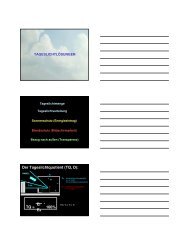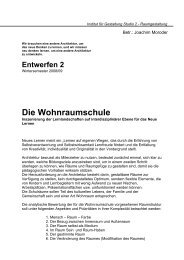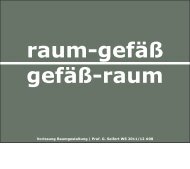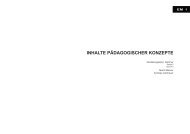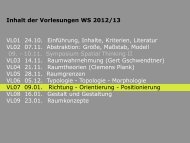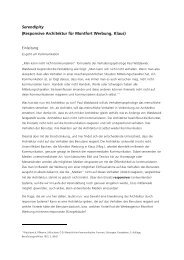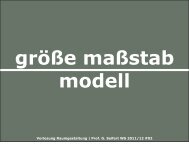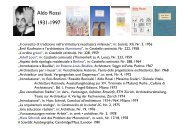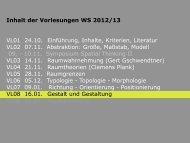Now switch off the sound and reverse the film
Now switch off the sound and reverse the film
Now switch off the sound and reverse the film
Create successful ePaper yourself
Turn your PDF publications into a flip-book with our unique Google optimized e-Paper software.
<strong>Now</strong> <strong>switch</strong> <strong>off</strong> <strong>the</strong> <strong>sound</strong> <strong>and</strong> <strong>reverse</strong> <strong>the</strong><br />
<strong>film</strong><br />
Koolhaas, Constant <strong>and</strong> Dutch culture in <strong>the</strong> 1960'sKoolhaas<br />
To each bastard, a genealogical tree.1)<br />
Rem Koolhaas<br />
En Indonesie, nous habitions les écuries d une très gr<strong>and</strong>e maison, entourée par un mur. Et, de<br />
l autre côté du mur, il y éatait un lavoir avec une série de bassins très longs et parallèles. Il y<br />
avait là de très belles femmes qui lavaient les draps de façon très lente, très érotique.... A un<br />
moment une sonnerie a reteni; c était l heure du déjeuner, les femmes sont parties. Des hommes<br />
sont arrivés, ils se sont déshabillés, ont pissé dans l eau et ont commencé à nager entre les draps.<br />
C était une gr<strong>and</strong>e expérience..... 2)<br />
- Rem Koolhaas<br />
It is an intriguing photograph in itself. On <strong>the</strong> far left, we see <strong>the</strong> artist/architect Constant Nieuwen-<br />
huys in his atelier in Amsterdam. He points towards a complex construction in <strong>the</strong> background.<br />
Two figures st<strong>and</strong> next to him, but <strong>the</strong> ink on <strong>the</strong> pink paper has faded to <strong>the</strong> point that <strong>the</strong>y are<br />
nearly unrecognizable. The image originally accompanied an interview with Constant published in<br />
a 1966 issue of <strong>the</strong> Haagse Post, a leading Dutch weekly magazine, on <strong>the</strong> occasion of <strong>the</strong><br />
presentation of his work in <strong>the</strong> Dutch pavillion at <strong>the</strong> Venice Biennale. 3) The interviewers are art<br />
critic Betty van Garrel <strong>and</strong> -on <strong>the</strong> far right of <strong>the</strong> picture, 22 years old <strong>and</strong> with a Beatles-hairdo -<br />
Rem Koolhaas. At first, it may not seem strange to see Koolhaas pictured with Constant; given<br />
Koolhaas s place in <strong>the</strong> architectural world today, it seems logical that he would have been<br />
attentive to Constant's work in <strong>the</strong> sixties. But at <strong>the</strong> time, Koolhaas was a journalist for <strong>the</strong> Haagse<br />
Post; nothing indicated that he was particularly interested in architecture. According to his former<br />
colleagues, he was mainly occupied filling <strong>the</strong> magazine s gossip page called People, Animals<br />
<strong>and</strong> Things , in which capacity he excelled in making up <strong>the</strong> most improbable details.<br />
o<strong>the</strong>r, more important job, was <strong>the</strong> definitive layout of <strong>the</strong> magazine, which was printed like a<br />
4) His<br />
newspaper –with lead type. He worked in <strong>the</strong> composing room at <strong>the</strong> printing <strong>off</strong>ice of <strong>the</strong> daily<br />
newspaper De Telegraaf.5)<br />
But Koolhaas was also responsible for a series of larger articles <strong>and</strong> interviews on subjects ranging<br />
from <strong>the</strong> most kitschy displays of Dutch schlager-culture (<strong>the</strong> Song Festival in Knokke); to
literature, <strong>film</strong> <strong>and</strong> motorsports (<strong>the</strong> 24 Hours of Le Mans); to politics (<strong>the</strong> PROVO-movement) to<br />
sex. He wrote only two articles on architecture: one on Le Corbusier <strong>and</strong> ano<strong>the</strong>r on<br />
H.Th.Wijdeveld. The interview with Constant thus seems to have been a rare exception. What<br />
would have provoked Koolhaas s interest in Constant at <strong>the</strong> time? What is its importance today?<br />
In recent years, academics in Europe, <strong>and</strong> particularly in <strong>the</strong> United States, have taken a renewed<br />
interest in <strong>the</strong> Situationists, <strong>the</strong> group of activists that radicalized cultural <strong>and</strong> political criticism<br />
between 1957 <strong>and</strong> 1972. As a result, several fundamental Situationist texts such as Guy Debord s<br />
The Society of <strong>the</strong> Spectacle <strong>and</strong> Raoul Vaneigem s The Revolution of Everyday Life have<br />
recently been translated into English or reprinted. Recently, <strong>the</strong> contribution of Constant<br />
Nieuwenhuys, ano<strong>the</strong>r former-situationist, has also been made available in Mark Wigley s<br />
Constant s New Babylon: The Hyper-Architecture of Desire, published on <strong>the</strong> occasion of a major<br />
exhibition on <strong>the</strong> project at <strong>the</strong> Witte de With center for contemporary art in Rotterdam. 5)<br />
Not surprisingly, several critics have begun to speculate on <strong>the</strong> possible influence of situationist<br />
thought on Rem Koolhaas.6) But <strong>the</strong>y remain puzzled that Koolhaas's thinking refrains from <strong>the</strong><br />
radical criticism of <strong>the</strong> spectacle <strong>and</strong> of capitalism that is so central to situationism, or at least<br />
that he presents this criticism in a different way, for instance by coining <strong>the</strong> term Junkspace (TM)<br />
to describe <strong>the</strong> artificial labyrintine, kitschy ambiences that fester inside modernist containers like<br />
airports <strong>and</strong> shopping malls, to accomodate shops, bars, restaurants, casino s ...... 7) Indeed, <strong>the</strong><br />
article in <strong>the</strong> Haagse Post proves that Koolhaas was aware of Constant's ideas in <strong>the</strong> sixties, but it<br />
doesn't openly reveal what he thought of <strong>the</strong>m. Since Constant has become canonized, no one<br />
seems to consider any more that Koolhaas could have been influenced by Constant in a negative or<br />
more ambivalent way, or that this influence might have been coloured by or mixed with o<strong>the</strong>rs.<br />
Koolhaas himself provides <strong>the</strong>se critics with few clues as to his possible links with <strong>the</strong> Situationists<br />
<strong>and</strong> instead cultivates <strong>the</strong> myth about himself that he produced with his autobiographical ‘novel’<br />
S,M,L,XL. 8) That myth begins with his architectural training at <strong>the</strong> AA School in London <strong>and</strong> <strong>the</strong><br />
writing of Delirious New York, as if nothing had happened before. In fact, Koolhaas already had<br />
two interesting careers behind him when he decided to become an architect - one in journalism, <strong>the</strong><br />
o<strong>the</strong>r in <strong>film</strong>making. To better underst<strong>and</strong> Koolhaas position towards Constant, it is important to<br />
have more insight into <strong>the</strong> particular Dutch cultural context of <strong>the</strong> 1960's, where <strong>the</strong> activities of<br />
<strong>the</strong>se two figures intersected.<br />
Constant
Constant was an influential voice in <strong>the</strong> Ne<strong>the</strong>rl<strong>and</strong>s in <strong>the</strong> sixties a kind of conscience for<br />
progressive architects <strong>and</strong> regarded as a guru by <strong>the</strong> PROVO-movement.10) New Babylon <strong>the</strong><br />
project he spent 20 years developing through drawings, paintings, maps, texts, <strong>and</strong> most strikingly,<br />
through models of soldered metal, wire, <strong>and</strong> plexiglass was presented, at various phases of its<br />
evolution, in museums, in art magazines, in lectures, <strong>and</strong> even on television.<br />
New Babylon is <strong>the</strong> model of a possible future city: completely covered, artificially climatized <strong>and</strong><br />
lit, <strong>and</strong> raised high above <strong>the</strong> ground on huge columns. Inhabitants are given access to<br />
powerful, ambience-creating resources to construct <strong>the</strong>ir own spaces whenever <strong>and</strong> wherever<br />
<strong>the</strong>y desire . Light, acoustics, color, ventilation, texture, temperature, <strong>and</strong> moisture are infinitely<br />
variable. Movable floors, partitions, ramps, ladders, bridges, <strong>and</strong> stairs are used to construct<br />
veritable labyrinths of <strong>the</strong> most heterogeneous forms in which desires continuously interact .<br />
New Babylonians play a game of <strong>the</strong>ir own designing, against a backdrop <strong>the</strong>y have designed<br />
<strong>the</strong>mselves. 11) The city itself consists of chains of <strong>the</strong>se multileveled structures that are strung<br />
across <strong>the</strong> l<strong>and</strong>scape. Underneath <strong>the</strong>m are fully automated factories, cars, <strong>and</strong> trains. Above fly<br />
helicopters. These means of transportation allow <strong>the</strong> inhabitants to dwell in this city in a radical<br />
derive: <strong>the</strong>y do not want to live in a fixed place, but drift <strong>and</strong> roam through <strong>the</strong> vast urban<br />
l<strong>and</strong>scape with its multiple changing ambiences. Since technology has made work obsolete, energy<br />
is channeled into collective creativity . According to Constant, it is not <strong>the</strong> laborer but <strong>the</strong><br />
player, not homo faber but homo ludens to whom <strong>the</strong> future belongs. 12) And New<br />
Babylon is <strong>the</strong> playground for this ludic society.<br />
Often, Constant presented his vision of <strong>the</strong> future through cinematically conceived slide shows,<br />
accompanied by <strong>sound</strong>-collages, that even today produce an eerily believable effect: Only a few<br />
human figures are visible, perched on <strong>the</strong> edge of a vast space, but <strong>the</strong> <strong>sound</strong>track fills <strong>the</strong> auditori-<br />
um with a metropolitan jumble of voices, traffic noises, machines, animals, <strong>and</strong> strange music. We<br />
hear <strong>the</strong> <strong>sound</strong>s of a life we cannot see, a life we are forced to imagine. 13)<br />
Architect or artist<br />
Mark Wigley calls Constant a hyper-architect : Indeed, he took on <strong>and</strong> exaggerated so many<br />
traits of <strong>the</strong> architect s typical behavior that he became more architect than any architect. 14)<br />
But however central <strong>the</strong> tools <strong>and</strong> methods of <strong>the</strong> architectural profession were to his work, how
spatial his proposals, however much he lectured <strong>and</strong> <strong>the</strong>orized, how intensively he engaged with<br />
architects like Aldo van Eyck, how far he went in his personification of <strong>the</strong> architect –lecturing,<br />
<strong>the</strong>orizing <strong>and</strong> so on; Constant came from art <strong>and</strong> was seen as an artist in <strong>the</strong> 1950s <strong>and</strong> 1960s. That<br />
he was taken so seriously by architects at <strong>the</strong> time was a result of <strong>the</strong> CIAM-debates in <strong>the</strong> 1940s<br />
<strong>and</strong> 1950s, in which modern artists –with <strong>the</strong>ir supposed ability to provide <strong>the</strong> city with new<br />
monumental symbols of communality- were considered crucial to <strong>the</strong> urban design process. After<br />
<strong>the</strong> Second World War <strong>the</strong>re was a feeling that modern architecture had lost terrain in <strong>the</strong> thirties<br />
<strong>and</strong> forties, because <strong>the</strong> neoclassical revival in that period, which involved large scale employment<br />
of artists, had been much more successful in providing exactly such symbols - albeit reactionary<br />
ones.<br />
Believing that <strong>the</strong>y had completely overlooked <strong>and</strong> underestimated <strong>the</strong>se issues in <strong>the</strong>ir drive for<br />
functionality <strong>and</strong> sobriety, 15) Dutch CIAM-members introduced Constant –still a member of<br />
CoBrA at <strong>the</strong> time –to <strong>the</strong>ir meetings. Some of <strong>the</strong> Dutch CIAM groups were -apart from Le<br />
Corbusier- more open to collaboration with artists than o<strong>the</strong>rs. This may have a historical<br />
background, because De Stijl originated in painting, but after <strong>the</strong> war also CoBrA painters like<br />
Karel Appel were regularly invited to realize important works in buildings by J.J.P. Oud, H.A.<br />
Maaskant <strong>and</strong> o<strong>the</strong>rs. Aldo van Eyck was even in close contact with COBRA. For Constant, his<br />
contacts with architects may have been impetus to rethink communality in a more drastic way,<br />
resulting after his first contacts with <strong>the</strong> situationists in whole urbanistic proposals. At <strong>the</strong><br />
peak of <strong>the</strong> successful realization of <strong>the</strong> postwar reconstruction of The Ne<strong>the</strong>rl<strong>and</strong>s, Constant<br />
provided not only a critical reading of modern architecture <strong>and</strong> urbanism, but also a much fur<strong>the</strong>r-<br />
reaching vision of <strong>the</strong> future, that was visionary, optimistic, idealistic, <strong>and</strong> artistic in nature.<br />
The Haagse Post<br />
When Rem Koolhaas started working for <strong>the</strong> Haagse Post in 1963, he was 19 years old. It was <strong>the</strong>n<br />
a rightwing liberal magazine –especially by Dutch st<strong>and</strong>ards – whose editor in chief, Mr.<br />
G.B.J.Hilterman, is still notorious today for <strong>the</strong> bronze voice he uses to deliver his Sunday radio-<br />
column, The Situation In The World , in which he polemically defends capitalism <strong>and</strong> <strong>the</strong> free<br />
market. But even more than conservatism, Hilterman valued independence, both for himself <strong>and</strong><br />
for <strong>the</strong> magazine. His wife, Sylvia Br<strong>and</strong>ts Buys, personified this independence but was more<br />
adventurous. Seeking a younger audience, she wanted to model <strong>the</strong> “HP” -as it is generally known-<br />
on L Express <strong>and</strong> Time, <strong>and</strong> recruited a series of non conformist younger journalists, a strange mix
of intellectuals <strong>and</strong> ragamuffins, that were all to become part of <strong>the</strong> sixties avant-garde. In general,<br />
HP was a strange <strong>and</strong> often schizophrenic mix of conservatism <strong>and</strong> eccentricity. It happened that<br />
one editor refused to work at a certain desk, because ano<strong>the</strong>r had made love on it <strong>the</strong> night before.<br />
17)<br />
Many editors <strong>and</strong> journalists at <strong>the</strong> Haagse Post had second careers in art, literature <strong>and</strong> <strong>film</strong>. 18) In<br />
fact, <strong>the</strong> magazine was almost a cover organization for <strong>the</strong> Nulbeweging ( Zero Movement , <strong>the</strong><br />
Dutch variant of <strong>the</strong> German ZERO movement <strong>and</strong> <strong>the</strong> French Nouveaux Réalistes), <strong>and</strong> De<br />
Nieuwe Stijl ( The New Style ), <strong>the</strong> corresponding literary movement. Arm<strong>and</strong>o, head of <strong>the</strong><br />
magazine s cultural section, was already a known painter <strong>and</strong> writer, but also a boxer who played<br />
<strong>the</strong> violin in gypsy b<strong>and</strong>s. At <strong>the</strong> time, he was painting with industrial paints on sheet-metal in<br />
place of canvas, to produce minimalist monochrome surfaces. He would wrap <strong>the</strong>se surfaces with<br />
barbed wire, or carefully screw a few bolts to make simple geometric patterns. His sculptures<br />
consisted of simple stackings of car tires. O<strong>the</strong>r members of <strong>the</strong> Nulbeweging <strong>and</strong> De Nieuwe Stijl<br />
who also wrote for HP included Hans Sleutelaar <strong>and</strong> Hans Verhagen, both poets with a sharp eye<br />
for everyday life <strong>and</strong> culture.<br />
Nul <strong>and</strong> De Nieuwe Stijl were clear reactions to <strong>the</strong> emotive style of CoBrA <strong>and</strong> to <strong>the</strong> correspon-<br />
ding Dutch literary movement, <strong>the</strong> Vijftigers, with <strong>the</strong>ir strong emphasis on individual expression<br />
<strong>and</strong> childlike innocence. 19) The Nul-members at HP were known as de Heertjes (<strong>the</strong><br />
Gentlemen), because <strong>the</strong>y refused <strong>the</strong> alternative style common to artists <strong>and</strong> journalists, <strong>and</strong><br />
instead wore elegant suits, like Koolhaas does in <strong>the</strong> vague photograph illustrating <strong>the</strong> interview<br />
with Constant. Arm<strong>and</strong>o s manifesto, Een internationale primeur, summed up what <strong>the</strong><br />
Nulbeweging stood for: Not moralizing or interpreting (art-ificing) <strong>the</strong> reality, but intensifying it.<br />
Starting point: an uncompromising acceptance of reality.(…) Working method: isolating, annexing.<br />
Thus: au<strong>the</strong>nticity. Not of <strong>the</strong> maker, but of <strong>the</strong> information. The artist who is no longer an artist,<br />
but a cold, rational eye. 20) The meaning of Nul <strong>and</strong> De Nieuwe Stijl was, in o<strong>the</strong>r words, to<br />
work with no style , to use an expression Koolhaas later applied in architectural terms. 21)<br />
The new style of journalism that was introduced in <strong>the</strong> Haagse Post tried to do something similar.<br />
Write it all down in a deadpan manner, with <strong>the</strong> amazement of someone who has just arrived<br />
from Mars , Arm<strong>and</strong>o instructed Betty van Garrel. 22) In <strong>the</strong> manifesto Instructions for <strong>the</strong><br />
press , written with Sleutelaar for De Nieuwe Stijl, he went even fur<strong>the</strong>r: Facts are more interes-<br />
ting than commentaries <strong>and</strong> guesses. Historical conscience is <strong>the</strong> only reliable guidance. ;<br />
Information remains necessary: not by means of opinions, but by means of facts. ; It has to
ecome evident as soon as possible that most critics are <strong>the</strong> bastards of journalism. ; These<br />
bastards have to leave <strong>the</strong> stage. 23)<br />
So, <strong>the</strong> journalists of HP did not so much give <strong>the</strong>ir opinions, but tried to describe, with precision<br />
<strong>and</strong> neutrality, what happened. The tape recorder became an indispensable tool: in interviews, <strong>the</strong>y<br />
wrote down as literally as possible <strong>and</strong> with a minimum of editing what <strong>the</strong>ir subjects said. In fact,<br />
Trino Flothuis developed a method of interviewing in which he stopped asking questions altoge<strong>the</strong>r<br />
<strong>and</strong> just waited with <strong>the</strong> microphone on for whatever his victims might say. Ano<strong>the</strong>r rule for <strong>the</strong><br />
Nul-journalist was that <strong>the</strong> <strong>off</strong>icial order of facts was arbitrary <strong>and</strong> <strong>the</strong>refore could be almost<br />
completely neglected: <strong>the</strong> waitress at <strong>the</strong> press conference of <strong>the</strong> prime minister was just as relevant<br />
as <strong>the</strong> prime minister himself.24) In <strong>the</strong> cultural section, <strong>the</strong>re was no distinction between high <strong>and</strong><br />
low art: both were treated in <strong>the</strong> same way.<br />
Indeed, Koolhaas first ever published larger article in 1964, on Le Corbusier, consists largely of<br />
his observations of a restless audience that has to wait because <strong>the</strong> architect s flight is delayed.<br />
Than a portrait of <strong>the</strong> architect: Le Corbusier, 76, with a dry, snappish appearance, a face in<br />
which only <strong>the</strong> under lip moves <strong>and</strong> pale blue eyes, makes an embittered impression. The largest<br />
part of his life he has worked on revolutionary plans that, when <strong>the</strong>y were worked out, were mostly<br />
ridiculized, but have a great influence today. And after that an original but adequate resume of Le<br />
Corbusiers works <strong>and</strong> ideas. 25)<br />
Writing With No Style<br />
In this new kind of journalism, <strong>the</strong> choice of <strong>the</strong> subjects became crucial: what was isolated? What<br />
was annexed? Arm<strong>and</strong>o considered poetry as <strong>the</strong> result of a (personal) selection from Reality. 26)<br />
In <strong>the</strong> mid-sixties <strong>the</strong>re was hardly a difference between <strong>the</strong> journalistic <strong>and</strong> <strong>the</strong> literary work of<br />
some of <strong>the</strong> contributors to <strong>the</strong> HP; it became far removed from a news magazine. At a time when<br />
tape recorders were still uncommon, this method of journalism could not only work as a tool, but<br />
also as a weapon, allowing for a certain amount of manipulation. Koolhaas, for instance, was a<br />
master at coloring <strong>the</strong> facts -<strong>and</strong> probably invented a few too. His detailed descriptions of <strong>the</strong><br />
clo<strong>the</strong>s worn by his subjects revealed much about what he thought about <strong>the</strong>m. But most important<br />
in Nul-journalism was <strong>the</strong> act of putting a topic on <strong>the</strong> agenda ra<strong>the</strong>r than reacting to what was<br />
already on it. To call attention to what was o<strong>the</strong>rwise neglected or considered trivial or unpopular<br />
became a new critical act. It exactly is this kind of critical act that distinguishes Koolhaas today<br />
when he puts topics like <strong>the</strong> Pearl River Delta, Africa, or shopping on <strong>the</strong> architectural agenda. 27)
The most impressive result of <strong>the</strong> symbiosis between <strong>the</strong> Haagse Post <strong>and</strong> Nul is undoubtedly <strong>the</strong><br />
book De SS ers (The SS-members) by Arm<strong>and</strong>o <strong>and</strong> Sleutelaar, first published in 1967. It<br />
consists of a series of interviews with Dutch volunteers in <strong>the</strong> German army during <strong>the</strong> Second<br />
World War. The interviews are hardly edited; <strong>the</strong> words of <strong>the</strong> subjects have been written down<br />
exactly as spoken. In <strong>the</strong>ir foreword, Arm<strong>and</strong>o <strong>and</strong> Sleutelaar write that <strong>the</strong> book was conceived<br />
out of curiosity; until than only <strong>the</strong> victims <strong>and</strong> <strong>the</strong> resistance had been heard. They also point out a<br />
similarity between <strong>the</strong> volunteers that fought on <strong>the</strong> right side <strong>and</strong> <strong>the</strong> ones that fought on <strong>the</strong><br />
wrong side: both hoped that <strong>the</strong>ir country would come out better <strong>off</strong> than it had been before. 28)<br />
Even before it was printed, <strong>the</strong> book caused an immense upheaval; many considered its approach<br />
dangerous <strong>and</strong> morally wrong. At <strong>the</strong> time, <strong>the</strong> Dutch were just trying to forget that a considerable<br />
segment of <strong>the</strong> population had actually voted for <strong>the</strong> Dutch National Socialist party before <strong>the</strong><br />
Second World War <strong>and</strong> that many collaborated, or had simply looked <strong>the</strong> o<strong>the</strong>r way. In fact,<br />
because <strong>the</strong> Dutch were generally obedient <strong>and</strong> efficient, providing <strong>the</strong> Germans with perfect<br />
registers, <strong>the</strong>y ultimately deported a higher percentage of <strong>the</strong> Jewish population to concentration<br />
camps than any o<strong>the</strong>r European country. But <strong>the</strong> Dutch had gone on to create a myth about a small<br />
but heroic people that had stood up against a more powerful diabolic suppressor, <strong>and</strong> in which it<br />
seemed that everyone had been active in <strong>the</strong> resistance or at least in hiding Jews. This myth was<br />
even taught in history classes at school <strong>and</strong> associated with <strong>the</strong> resistance tot <strong>the</strong> Spanish in <strong>the</strong><br />
sixteenth century, after which The Ne<strong>the</strong>rl<strong>and</strong>s had become an independent state.<br />
In <strong>the</strong> 1960s, <strong>the</strong> Provos exploited this myth when <strong>the</strong>y accused <strong>the</strong> right wing establishment of<br />
being a secret continuation of fascism. This led to one of <strong>the</strong>ir most notorious actions - setting fire,<br />
in 1966, to <strong>the</strong> headquarters of De Telegraaf , a newspaper that had appeared throughout <strong>the</strong> war<br />
<strong>and</strong> was critical of PROVO, unlike o<strong>the</strong>r newspapers <strong>and</strong> magazines, which, having originated in<br />
<strong>the</strong> resistance, were more sympa<strong>the</strong>tic towards <strong>the</strong> movement. The riots were instigated by a report<br />
in De Telgraaf on <strong>the</strong> killing of a worker during a demonstration: <strong>the</strong> report attributed <strong>the</strong> death to a<br />
stone throw by one of <strong>the</strong> demonstrators, when in fact <strong>the</strong> man had been killed by <strong>the</strong> police. But<br />
mostly, <strong>the</strong> incident stood out for its raw violence <strong>and</strong> destruction in <strong>the</strong> name of good intentions.<br />
Cynically, <strong>the</strong> Provo’s actions could be read as <strong>the</strong> mirror image of similar activities carried out by<br />
<strong>the</strong> Nazis.<br />
From <strong>the</strong>ir <strong>off</strong>ices, <strong>the</strong> editors of HP had an excellent view of <strong>the</strong> riots; Koolhaas, who happened to<br />
be working in <strong>the</strong> printing <strong>off</strong>ice in <strong>the</strong> Telegraaf building at <strong>the</strong> time, found himself trapped in <strong>the</strong>
middle of <strong>the</strong>m, <strong>and</strong> climbing over roofs <strong>and</strong> through a barbershop to escape. Hiltermann <strong>and</strong><br />
Br<strong>and</strong>ts Buys regarded <strong>the</strong> riots as <strong>the</strong> culmination of a series of incidents in which <strong>the</strong><br />
establishment, <strong>the</strong> royal family <strong>and</strong> <strong>the</strong> church were tarnished. Though some articles in HP sided<br />
with that campaign, Hiltermann himself, in his weekly columns, had criticized it in <strong>the</strong> most<br />
reactionary way. Br<strong>and</strong>ts Buys ordered Hans Sleutelaar to write a very critical story on <strong>the</strong> riots,<br />
but he refused <strong>and</strong> was fired.29) Instead, Koolhaas did <strong>the</strong> job, toge<strong>the</strong>r with his collegues Flothuis<br />
<strong>and</strong> Van Wansbeek.<br />
It was <strong>the</strong> Provo’s use of violence, in particular, that led Koolhaas to attack <strong>the</strong>m in <strong>the</strong> most<br />
cynical <strong>and</strong> sarcastical way. Entitled “Boredom <strong>and</strong> Leisure” <strong>and</strong> placed under <strong>the</strong> special new<br />
heading “Sociology/Politics”, <strong>the</strong> interview portrays <strong>the</strong> Provos as a bunch of spoiled adolescents<br />
who have taken Constant’s ideas about homo ludens a bit too literally. Appearing confused about<br />
<strong>the</strong>ir own motives, <strong>the</strong> Provos paradoxically come across as reactionary, ra<strong>the</strong>r than progressive. By<br />
recording <strong>the</strong>ir answers literally, <strong>the</strong> interviewers enhance this effect:<br />
HP: No wonder sociologists call you reactionary: you resemble <strong>the</strong> people that lamented when in<br />
1825 <strong>the</strong> first train rode between Stockton en Darlington in Engl<strong>and</strong>.<br />
Tuynman: No, individual man is definitely threatened by civilization. Sorry, I drop cigarette-ashes<br />
in <strong>the</strong> microphone of <strong>the</strong> tape-recorder. Man is threatened in his individuality by <strong>the</strong> developments<br />
in communication <strong>and</strong> in <strong>the</strong> sciences. And on this threat of <strong>the</strong> individuality our feeling of<br />
collectivity is founded. I admit, it <strong>sound</strong>s like a paradox. 30)<br />
In <strong>the</strong> photograph that accompanies <strong>the</strong> interview, we see an elegantly dressed Rem Koolhaas in <strong>the</strong><br />
center, suspiciously eyeing a group of long-haired, dirty, bearded <strong>and</strong> smoking Provos. From this<br />
article onwards, Koolhaas became much more prominent in HP, notably with a series of articles<br />
that criticized Provo, Hippies <strong>and</strong> people that inspired <strong>the</strong>m -like Constant- or sympathized with<br />
<strong>the</strong>m -like writer Harry Mulisch. 31)<br />
1, 2, 3, enz.<br />
Like many of his colleagues at HP, Rem Koolhaas had a second career: he was in <strong>film</strong>, as a<br />
member of <strong>the</strong> group called 1, 2, 3 enz. . 1,2,3 enz. ( 1,2,3 etc. ) was a bratpack including<br />
Rene Daalder, Rem’s friend since high school, <strong>and</strong> a group of his friends from <strong>the</strong> Amsterdam Film<br />
Academy. Rem s fa<strong>the</strong>r, Anton Koolhaas a Dutch writer <strong>and</strong> novelist famous for his stories<br />
featuring animals was director of <strong>the</strong> Amsterdam Film Academy at <strong>the</strong> time. The composition<br />
<strong>and</strong> size of <strong>the</strong> group changed (hence <strong>the</strong> enz. ), but <strong>the</strong> most notorious o<strong>the</strong>r members were
Frans Bromet -a cameraman who became nationally famous as <strong>the</strong> maker of innovative TV-<br />
documentaries-; Kees (now: Samuel) Meyering, who became rich as <strong>the</strong> inventor of <strong>the</strong> Rolykit, a<br />
special folding toolbox; <strong>and</strong> Jan de Bont - now known as <strong>the</strong> cameraman of Black Rain , <strong>and</strong> <strong>the</strong><br />
maker of Hollywood blockbusters like Speed, Twister, <strong>and</strong>, most recently, The Haunting. Director<br />
Pim de la Parra <strong>and</strong> cameraman Robbie Muller -now known for his work with, among o<strong>the</strong>rs,<br />
Wim Wenders <strong>and</strong> Jim Jarmusch- were also transient members.<br />
1, 2, 3 enz. mocked anything considered fashionable in <strong>the</strong> sixties -especially anything that was<br />
personal, artistic, idealistic, or intellectual, like <strong>the</strong> art house cinema <strong>and</strong> notably <strong>the</strong> Cinema<br />
d Auteur. For a <strong>film</strong> to have only one author seemed to <strong>the</strong>m a nineteenth-century idea. In three<br />
manifestoes, that were printed parallel above each o<strong>the</strong>r on <strong>the</strong> pages of <strong>the</strong> Dutch <strong>film</strong> magazine<br />
Skoop (as a reaction to earlier, negative critiques of Jack Clayton’s 1965 <strong>film</strong> The Pumpkin Eater),<br />
Kees Meyering, Rene Daalder <strong>and</strong> Rem Koolhaas argued that <strong>film</strong>s should be judged as teamwork<br />
– that actors, director, cameramen, screenplay writers <strong>and</strong> so on made equally important<br />
contributions to <strong>the</strong> final result. 32) They saw all of <strong>the</strong>se roles as specializations in <strong>the</strong> <strong>film</strong>making<br />
process, <strong>and</strong> believed that one person could combine several roles, or people could even <strong>switch</strong><br />
from one role to ano<strong>the</strong>r. That made it possible to adapt a crew to a budget <strong>and</strong>, as in a jazz b<strong>and</strong>, to<br />
spontaneously start improvising <strong>and</strong> working. In <strong>the</strong>ir first <strong>film</strong>, 1, 2, 3 Rhapsodie from 1965, each<br />
participant shifted from cameraman, to actor, to director. But it was not all play <strong>and</strong> anarchy; on <strong>the</strong><br />
contrary: <strong>the</strong> group was quite ambitious, believing that a <strong>film</strong> industry in Europe, similar to that of<br />
<strong>the</strong> US, could emerge.<br />
The <strong>film</strong>combo<br />
1, 2, 3 enz. saw a chain of evidence that <strong>film</strong>making was a collective effort. In <strong>the</strong> three interwoven<br />
manifestoes in Skoop, Kees Meyering spoke of a new type of director – one who was not<br />
necessarily interested in making personal <strong>film</strong>s, as Michelangelo Antonioni would be 33); Rene<br />
Daalder emphasized <strong>the</strong> creative role of individual actors <strong>and</strong> how <strong>the</strong> director could get <strong>the</strong> most<br />
out of <strong>the</strong>m 34); <strong>and</strong> Koolhaas emphasized <strong>the</strong> importance of <strong>the</strong> screenplay writer. He thought that<br />
Dutch <strong>film</strong> had more in common with British <strong>film</strong> than with <strong>the</strong> French Nouvelle Vague <strong>and</strong> talked<br />
mainly about Harold Pinter.35) A few years later, Jan de Bont analyzed <strong>the</strong> organization, <strong>the</strong><br />
camerawork <strong>and</strong> <strong>the</strong> special effects on <strong>the</strong> set of Guy Hamilton s The Battle of Britain <strong>and</strong><br />
published his findings in an extensive article in Skoop.36) With <strong>the</strong>ir interest in teamwork <strong>and</strong> a<br />
professionalism, it is no coincidence that photographers like Jan de Bont <strong>and</strong> Frans Bromet
developed into complete <strong>film</strong>makers, <strong>and</strong> director Rene Daalder became one of Hollywood’s<br />
pioneers in digital technology.<br />
Also in 1965, Rem Koolhaas published one of his longest articles in HP, on Federico Fellini - one<br />
of <strong>the</strong> directors Kees Meyering had mentioned as <strong>the</strong> representative of a new type. The occasion of<br />
<strong>the</strong> article was Fellini s latest <strong>film</strong>, Giulietta <strong>and</strong> <strong>the</strong> Spirits , around his wife Giulietta Masina,<br />
who had appeared earlier in La Strada. Koolhaas’ piece is one of <strong>the</strong> finest examples of sixties HP-<br />
journalism. It had to be, because, as it is revealed in <strong>the</strong> course of <strong>the</strong> article, Fellini did not really<br />
want to talk with Koolhaas at all. Koolhaas <strong>the</strong>refore puts all his energy into extensive <strong>and</strong> bizarre<br />
descriptions of Fellini s appearance, his <strong>off</strong>ice, <strong>the</strong> way in which he corrects an interview in<br />
Playboy, <strong>and</strong> his manner of dealing with o<strong>the</strong>r people -notably his barber, a lawyer <strong>and</strong> Koolhaas<br />
himself, who is sent out while <strong>the</strong> master is doing apparently senseless things in his room.<br />
Mystery, probably Fellini s most loved attribute, comes into play.....<br />
Because Fellini himself is not willing to speak, Koolhaas interviews Masina, adding plenty of<br />
malicious gossip, <strong>and</strong> Fellini s master decorator Piero Gherardi, who also appears to be<br />
completely filled with <strong>the</strong> most false gossip <strong>and</strong> apart from that celebrates his honeymoon with<br />
his false teeth, so that his lisping gives him something even more vicious . 37) All in all, Fellini is<br />
portrayed as an enigmatic, obstinate genius, surrounded by idiots <strong>and</strong> parasites, who strangely<br />
enough seem to have a great influence on his work -for better or for worse.<br />
A sadistic universe<br />
Apart from <strong>the</strong> group’s ideas about <strong>film</strong> as a collaborative effort, <strong>the</strong>re was most certainly one o<strong>the</strong>r<br />
important influence on Koolhaas thinking: <strong>the</strong> works of <strong>the</strong> Dutch writer Willem Frederik<br />
Hermans. Considered as <strong>the</strong> most important postwar Dutch writer, has built up a body of work in<br />
which <strong>the</strong> human existence is characterized by uncertainty: a chaotic, Sadistic Universe 38), as<br />
one of his most provocative collection of essays is titled, where man cannot distinguish his friends<br />
from his enemies, <strong>and</strong> where his enemy today could become his friend tomorrow. Heroes are<br />
people who have been reckless without being punished; idealism is a gamble - <strong>and</strong> it could very<br />
well be a wrong bet. It’s no wonder, that Hermans was one of <strong>the</strong> few to praise Arm<strong>and</strong>o <strong>and</strong><br />
Sleutelaar s De SS -ers : he himself had been <strong>the</strong> first to question <strong>the</strong> myth of Dutch heroism<br />
during <strong>the</strong> Second World War in many of his novels, short stories <strong>and</strong> plays.<br />
In <strong>the</strong> fifties <strong>and</strong> sixties, several Dutch <strong>film</strong>makers chose to base <strong>the</strong>ir screenplays on novels by
Hermans. Generally very critical about those attempts, Hermans was prompted to write a series of<br />
polemical articles on Dutch <strong>film</strong> that were greatly enjoyed <strong>and</strong> admired by 1, 2, 3, enz..<br />
Apart from Wittgenstein, whose Tractatus he would translate into Dutch in 1975, Hermans was<br />
influenced by Freud s discovery of <strong>the</strong> existence of <strong>the</strong> subconscious <strong>and</strong> its role in human<br />
behaviour.39) According to Hermans, we could be hypnotized by <strong>the</strong> commercial media, but even<br />
our resistance to this posthypnotic influence is compulsory as a superficial investigation of<br />
alcoholics, vegetarians, abstinents, idealists, criminals <strong>and</strong> artists learns . Not one eccentric<br />
could come up with something completely new <strong>and</strong> by <strong>the</strong> way, who would appreciate that? Resis-<br />
tance is accepted within <strong>the</strong> framework of <strong>the</strong> docile whole. The traditional society carries <strong>the</strong><br />
artists’ society like some skyscrapers bear a baroque tower or a Morish villa on <strong>the</strong>ir roof. 40)<br />
Hermans novel De Donkere Kamer van Damocles (The Dark Room of Damocles) from 1958<br />
is about <strong>the</strong> weak adolescent Henri Osewoudt, who, during <strong>the</strong> German occupation, gets to know a<br />
character called Dorbeck. 41) Dorbeck is Osewoudt’s counterpart in everything; <strong>the</strong>y look similar<br />
like a negative of a photograph looks like a positive , according to Osewoudts wife. Because of<br />
him Osewoudt becomes a hero of <strong>the</strong> resistance -or at least he thinks he does. Because, as it is<br />
typical in <strong>the</strong> work of Hermans, in <strong>the</strong> end <strong>the</strong> plot contains a crucial reversal or twist: immediately<br />
after <strong>the</strong> war, Osewoudt is imprisoned on accusation of betrayal. Only Dorbeck can prove his<br />
innocence, but he is not to be found. Osewoudt s last resort is a photograph that he had taken of<br />
Dorbeck <strong>and</strong> himself in front of a mirror. But when <strong>the</strong> <strong>film</strong> is found <strong>and</strong> he is finally allowed to<br />
develop it, <strong>the</strong> only picture on it is one of himself <strong>and</strong> an SS-Obersturmführer. When he runs away<br />
in disbelief <strong>and</strong> despair, shouting that his prosecutors should try to find Dorbeck, he is shot by <strong>the</strong><br />
prison guards. The prosecutors laugh, <strong>the</strong> SS -prisoners yell murder! <strong>and</strong> <strong>the</strong> only a priest will<br />
believe Osewoudt <strong>and</strong> come to his aid. We are left to wonder whe<strong>the</strong>r Osewoudt has been a hero, a<br />
collaborator or has done it all for his own reasons. All evidence -even though it is circumstantial-<br />
is against him. In fact, <strong>the</strong> book never actually explains why Osewoudt follows Dorbecks orders<br />
without question; indeed <strong>the</strong> Dutch reader –conditioned by <strong>the</strong> myth of Dutch heroism- takes it for<br />
granted that Osewoudt’s actions are intended as an act of resistance to <strong>the</strong> Germans. In <strong>the</strong> end, <strong>the</strong><br />
novel tests <strong>the</strong> reader’s st<strong>and</strong> on this myth; is he a pessimist or an optimist?<br />
De Donkere Kamer van Damocles opens with a story told by a school teacher to a class about a<br />
shipwrecked man, who has saved himself on a raft, but without anything to drink. The man resents<br />
<strong>the</strong> salt water that surrounds him, because he can t drink it. But when lightning strikes his mast<br />
<strong>and</strong> catches fire, he doesn t know how quickly to use <strong>the</strong> hated water to extinguish it. The teacher<br />
<strong>and</strong> <strong>the</strong> class laugh with <strong>the</strong> underst<strong>and</strong>ing that whe<strong>the</strong>r or not he succeeds in putting out <strong>the</strong> fire,
he is doomed to die anyway. It is a parable that returns only a little bit different as Koolhaas’s<br />
decadent plastic version, <strong>the</strong> Raft of Medusa , which plays such an enigmatic <strong>and</strong> crucial role in<br />
<strong>the</strong> fictional conclusion of Delirious New York. This time, Koolhaas explains in a fotocaption, <strong>the</strong><br />
shipwrecked soldiers only had wine to drink <strong>and</strong> in a premature <strong>and</strong> drunken panic started to<br />
cannibalize each o<strong>the</strong>r already on <strong>the</strong> second day of <strong>the</strong>ir journey. Saved on <strong>the</strong> 7th day of <strong>the</strong><br />
shipwreck, <strong>the</strong>y could easily have survived without eating anything at all. 42) In Delirous New<br />
York, The Raft of Medusa finally collides with <strong>the</strong> Pool of <strong>the</strong> constructivists. Optimism vs.<br />
pessimism. The steel of <strong>the</strong> pool slices through <strong>the</strong> plastic of <strong>the</strong> sculpture like a knife through<br />
butter , Koolhaas concludes. 43)<br />
Rem Koolhaas greatly admired Hermans in <strong>the</strong> nineteen sixties <strong>and</strong> <strong>the</strong> influence Hermans had on<br />
his thinking can hardly be overestimated. In his manifesto Een Delftsblauwe Toekomst in<br />
Skoop, Koolhaas already suggested that one of Hermans novels should be made into a <strong>film</strong>. 44)<br />
When Hermans novel Nooit meer slapen (Never Sleep Again), came out in 1966, Koolhaas<br />
visited <strong>the</strong> author in Groningen ad praised <strong>the</strong> book in a review in <strong>the</strong> Haagse Post where he applies<br />
<strong>the</strong> same twists in plot that are so characteristic of Hermans’s plots. 43) Not long after that, in 1967,<br />
Hermans became a regular columnist of <strong>the</strong> Haagse Post; his first contributions were mainly about<br />
<strong>film</strong>, which could hardly have been a coincidence.<br />
Rene Daalder<br />
Driving force behind 1, 2, 3, enz. was Koolhaas youthfriend Rene Daalder. His first short <strong>film</strong>s<br />
were widely praised, both in <strong>the</strong> press <strong>and</strong> at festivals; in fact he <strong>and</strong> cameraman Jan de Bont were<br />
widely considered <strong>the</strong> greatest talents Dutch cinema had ever known. Daalders first short movie,<br />
Body <strong>and</strong> Soul (1966), is set at a party given by a group of intellectuals, who ridicule one of <strong>the</strong><br />
guests, a bodybuilder, because of his obsession with <strong>the</strong> corporal. They force him to undress or<br />
better, <strong>the</strong>y rip <strong>off</strong> his clo<strong>the</strong>s <strong>and</strong> make him pose as Atlas, bearing a study-globe on his shoul-<br />
ders. But when <strong>the</strong> party gets out of h<strong>and</strong> <strong>and</strong> <strong>the</strong>ir bantering becomes violent, it is <strong>the</strong> bodybuilder<br />
that saves <strong>the</strong> globe from being destroyed. The <strong>film</strong> has no dialogue, but a voice over that<br />
comments on <strong>the</strong> events. The <strong>film</strong> won several prizes at Dutch <strong>film</strong> festivals at <strong>the</strong> time <strong>and</strong> as such<br />
paved <strong>the</strong> way for <strong>the</strong> financing of larger projects.<br />
Body <strong>and</strong> Soul 2 (1967), about a woman <strong>and</strong> her younger lover, won even more praise. In <strong>the</strong><br />
reviews of <strong>the</strong> <strong>film</strong>, critics mentioned <strong>the</strong> work of W.F.Hermans, not only in reference to <strong>the</strong> <strong>film</strong>’s<br />
use of melodrama, but also because of <strong>the</strong> reversals in <strong>the</strong> plot, that in de end save <strong>the</strong> movie from
eing a parody, <strong>and</strong> instead make it into a satire of a satire. What intellectuals would consider to be<br />
kitsch <strong>and</strong> clichés thus appear as people s deepest <strong>and</strong> most real desires, which are hence beyond<br />
mockery.<br />
Daalder s most ambitious project, The White Slave, became <strong>the</strong> most expensive Dutch <strong>film</strong><br />
produced to that day. The scenario was written by Daalder <strong>and</strong> Koolhaas toge<strong>the</strong>r; director of<br />
photography was Oliver Wood, who worked more recently on <strong>film</strong>s such as Face Off; <strong>and</strong> camera-<br />
man was again Jan de Bont. It premiered in 1969 at Amsterdam s Tuchinsky Theater (<strong>the</strong><br />
producer rented a camel as a stunt), but Daalder <strong>and</strong> Koolhaas were not allowed to take <strong>the</strong>ir seats<br />
in <strong>the</strong> front row, because <strong>the</strong> security attendants thought <strong>the</strong>y looked way too young to be <strong>the</strong> real<br />
director <strong>and</strong> scriptwriter.<br />
The protagonist of The White Slave is a good German with <strong>the</strong> unlikely name Gün<strong>the</strong>r Unrat (=<br />
danger), played by <strong>the</strong> <strong>the</strong>n well-known German actor with <strong>the</strong> similarly unlikely name Gün<strong>the</strong>r<br />
Ungeheuer (= monster). Unrat, who had gone into hiding in <strong>the</strong> Ne<strong>the</strong>rl<strong>and</strong>s during <strong>the</strong> war,<br />
returns, at <strong>the</strong> beginning of <strong>the</strong> <strong>film</strong>, to his former underground address. He is a sort of Simon<br />
Wiesenthal, searching not for more war criminals, but for o<strong>the</strong>r good Germans. This proves not<br />
to be easy, but Unrat is determined to compensate for all <strong>the</strong> bad things <strong>the</strong> Germans had done<br />
during <strong>the</strong> war. A drama develops or better a melodrama with a plot reminiscent of novels by<br />
W.F.Hermans, especially in <strong>the</strong> reversals. Unrat is persuaded by a mysterious Easterner (who<br />
claims to be a former assistant to Albert Schweizer <strong>and</strong> is played by <strong>the</strong> Israeli actor Issy<br />
Abrahami) to help him select girls who will be sent to an African bro<strong>the</strong>l, where <strong>the</strong>y will work as<br />
white slaves. Unrat <strong>and</strong> <strong>the</strong> girls are of course ignorant of <strong>the</strong>ir fate: <strong>the</strong>y think <strong>the</strong> girls will be<br />
trained as nurses to work in overseas aid projects a wonderful ideal. After a short training session<br />
in Berlage s hunting lodge at <strong>the</strong> Hoge Veluwe, that involves what is for Unrat a confusing course<br />
in naturism, <strong>the</strong> girls are taken away by Abrahami <strong>and</strong> brought to an Arab bro<strong>the</strong>l in <strong>the</strong> desert,<br />
where <strong>the</strong>y perform belly-dances to <strong>the</strong> score of Antoine duHamel, known from ao. <strong>the</strong> <strong>film</strong>s of<br />
François Truffaut. The <strong>film</strong> also features sex between people older than fifty a provocation<br />
<strong>and</strong> a gun in a drawer that is never used a mortal sin in scriptwriting according to Hitchcock, but<br />
also an inside joke referring to an essay W.F.Hermans wrote on Dutch <strong>film</strong>.46) In fact, everything<br />
ultimately turns out differently than one would expect, but it comes as no surprise that all Unrat s<br />
ideals are shattered, <strong>and</strong> at <strong>the</strong> end of <strong>the</strong> <strong>film</strong>, his hair turns gray in one night.<br />
Although <strong>the</strong>re is a general consensus today that The White Slave marked <strong>the</strong> moment Dutch<br />
cinema became mature, <strong>and</strong> Jan de Bont s camerawork was widely praised, it was an enormous
flop commercially. In a way, <strong>the</strong> <strong>film</strong> s failure itself was <strong>the</strong> ironical proof of its underlying idea<br />
that ideals can always result in <strong>the</strong> opposite effect one might have hoped, because it is impossible to<br />
know <strong>the</strong> real motives on which people act.<br />
Architecture<br />
So nothing indicated in 1966 that Koolhaas was interested in becoming an architect when he went<br />
to interview Constant. But only one year later, when <strong>the</strong> Haagse Post hired a new editor-in-chief,<br />
Koolhaas resigned after his series of four large articles on Sex in The Ne<strong>the</strong>rl<strong>and</strong>s , based on<br />
intensive research, was heavily criticized.47) He found new inspiration in a seminar on <strong>film</strong> <strong>and</strong><br />
architecture at <strong>the</strong> university in Delft. One of <strong>the</strong> tutors <strong>the</strong>re, Gerrit Oorthuys, had invited <strong>the</strong><br />
1,2,3, enz. group to participate, confessing that he was jealous of <strong>the</strong> work <strong>the</strong>y did <strong>and</strong> of <strong>the</strong>ir<br />
as he presumed wild lifestyle. Koolhaas tried to convince him that <strong>film</strong>making was actually an<br />
even more difficult, painstaking, <strong>and</strong> boring process than architecture <strong>and</strong> that architecture was in<br />
fact a more important occupation. Perhaps he went so far that he started to believe this himself;<br />
shortly after, he went to London to study at <strong>the</strong> AA School.<br />
As a student at <strong>the</strong> AA, Koolhaas would still occasionally write scripts with Rene Daalder. In an<br />
interview with AMC Koolhaas once stated that <strong>the</strong>y collaborated, during this period, on projects<br />
with Russ Meyer, <strong>the</strong> King of Soft-Porn (in Koolhaas s own words), but this was more myth<br />
than reality.48) Meyer made a series of <strong>film</strong>s that play with <strong>the</strong> genres of pornographic, detective<br />
<strong>and</strong> exploitation movies, but in which everything turns out <strong>the</strong> o<strong>the</strong>r way one would expect: women<br />
with gigantic breasts appear as a kind of Nietszchean superwomen: absolute heroes, that are in<br />
complete control of <strong>the</strong> situation, both physically <strong>and</strong> mentally. Meyer often was not only <strong>the</strong><br />
director, but also <strong>the</strong> cameraman <strong>and</strong> screenplay writer of his own movies. So in many ways, for<br />
Daalder <strong>and</strong> Koolhaas, he was almost <strong>the</strong> personification of <strong>the</strong> ideal <strong>film</strong>maker in <strong>the</strong> 1960s <strong>and</strong><br />
70s. Daalder collaborated with Meyer for several years <strong>and</strong> definitively settled in Hollywood.<br />
Occasionally Koolhaas would visit him in <strong>the</strong>re <strong>and</strong> in <strong>the</strong> beginning of that period; Daalder <strong>and</strong><br />
Koolhaas collaborated on a treatment for a <strong>film</strong> to be called Hollywood Tower . In that <strong>film</strong><br />
Russ Meyer was supposed to play <strong>the</strong> last movie mogul. According to Rene Daalder, who even<br />
talked to Chet Baker about doing <strong>the</strong> music, <strong>the</strong> story dealt with a pivotal moment in <strong>the</strong> future of<br />
Hollywood when real actors were going to be made obsolete by life-like computer generated<br />
performers. Along, of course with digital studio back lots, lighting, etc. - all of which would<br />
become artificial. Russ Meyer - <strong>the</strong> King of <strong>the</strong> Nudies himself - represented humanity s last
stance. Edy Williams, his super busty sex goddess girlfriend at <strong>the</strong> time, <strong>and</strong> Tippi Hedren (of<br />
Hitchcock s The Birds <strong>and</strong> Marnie ) were going to be <strong>the</strong> last human movie stars in Russ s<br />
<strong>film</strong> within <strong>the</strong> <strong>film</strong>. 49)<br />
From <strong>the</strong>n on, Koolhaas <strong>and</strong> Daalder more <strong>and</strong> more went in increasingly seperate directions.<br />
Koolhaas was not particularly fond of Los Angeles <strong>and</strong> Hollywood. He wrote his Delirious New<br />
York , established his name in architecture <strong>and</strong> finally returned to The Ne<strong>the</strong>rl<strong>and</strong>s. Daalder<br />
decided to stay in Hollywood, where he collaborated with people like for example Malcolm<br />
McLaren <strong>and</strong> <strong>the</strong> Sex Pistols, but also made several <strong>film</strong>s that gained a cult status <strong>and</strong> pioneered in<br />
music <strong>and</strong> digital technology.<br />
A novelist<br />
Although Koolhaas rarely mentions this part of his personal history since producing his<br />
autobiographical novel S,M,L,XL, <strong>the</strong> cultural climate of <strong>the</strong> Haagse Post, <strong>film</strong>making <strong>and</strong> <strong>the</strong><br />
writings of W.F.Hermans made a lasting impression on his work <strong>and</strong> thinking, that is essentially<br />
journalistic <strong>and</strong> literary in nature. For Hermans, by <strong>the</strong> way, <strong>the</strong> only difference between<br />
‘journalistic’ <strong>and</strong> ‘literary’ is that <strong>the</strong> journalist writes what <strong>the</strong> masses think <strong>and</strong> that <strong>the</strong> writer<br />
disputes what <strong>the</strong> masses think <strong>and</strong> brings to light what <strong>the</strong> masses do not dare to think. This does<br />
not mean he st<strong>and</strong>s above <strong>the</strong> masses, but that <strong>the</strong>re is a deeply hidden solidarity between <strong>the</strong>m; a<br />
writer despises <strong>the</strong> masses as much as he despises himself: The reader hates himself in <strong>the</strong> writer,<br />
<strong>the</strong> writer hates himself in his protagonists. 50) In that sense Koolhaas is more a novelist than a<br />
journalist.<br />
The echo of Arm<strong>and</strong>o s manifesto can be heard when Koolhaas speaks about <strong>the</strong> method of OMA<br />
as a systematic idealization a systematic overestimation of what exists. 51) One of Koolhaas's<br />
earliest descriptions of <strong>the</strong> city as a plane of tarmac with some hot spots of intensity on it 52) is<br />
almost a description of a gigantic Arm<strong>and</strong>o painting; in his laudatory text “Typical Plan in<br />
S,M,L,XL he even hints at <strong>the</strong> hidden affinities between this kind of plan, that was so characteristic<br />
for <strong>the</strong> anonymous American skyscraper typical of <strong>the</strong> 1960s, with o<strong>the</strong>r contemporary movements<br />
in <strong>the</strong> arts: It is zero-degree architecture, architecture stripped of all traces of uniqueness <strong>and</strong><br />
specificity. 53)<br />
About Koolhaas background in <strong>film</strong>making a lot has been said, but here it is maybe good to<br />
emphasize that <strong>the</strong> most important contribution to architecture that originates from that field is <strong>the</strong><br />
scenario. This scenario not only organizes <strong>the</strong> program of a building in a story with a plot, but <strong>the</strong>
uilding itself is also part of a larger plot. A plot is a story that grows organically through what <strong>the</strong><br />
protagonists of a novel or a <strong>film</strong> do. A plot is a literary ra<strong>the</strong>r than a visual influence – a story that<br />
grows organically through <strong>the</strong> actions <strong>and</strong> reactions of protagonists of a novel or a <strong>film</strong>.54) It gives<br />
a possible, mythological order to reality - but it is never reality itself, which is essentially chaotic.<br />
The awareness of this unreal literary order is expressed in Koolhaas preference for <strong>the</strong> paradox<br />
<strong>and</strong> <strong>the</strong> oxymoron that both connect seemingly different or even opposite phenomena.<br />
Research<br />
The impression made on Koolhaas by Constant <strong>and</strong> <strong>the</strong> Situationists was filtered through his<br />
experiences prior to becoming an architect. So, however tempting it may be to speak about <strong>the</strong><br />
influence Constant <strong>and</strong> <strong>the</strong> Situationists may have had on Koolhaas thinking as an architect<br />
through <strong>the</strong> obvious visual correspondences between some of <strong>the</strong> work of OMA <strong>and</strong> <strong>the</strong> models<br />
<strong>and</strong> drawings of New Babylon: <strong>the</strong> continuous folding floor planes, <strong>the</strong> use of constructions to<br />
define spaces instead of walls <strong>and</strong> <strong>the</strong> appearance of existing city-plans in collages of designs for<br />
o<strong>the</strong>r cities; though one could also point out <strong>the</strong> sculptural qualities of many OMA models that in<br />
<strong>the</strong>ir h<strong>and</strong>crafted detailing, <strong>the</strong>ir use of materials, <strong>and</strong> <strong>the</strong>ir scale come close to some models of<br />
New Babylon; however important it may seem to mention that many of OMA s models were built<br />
to be shown as photographs, ra<strong>the</strong>r than as objects, like those of Constant which were carefully<br />
constructed to reinforce <strong>the</strong> sense of <strong>the</strong> transitory 55); <strong>and</strong> despite <strong>the</strong> fact that <strong>the</strong>y share(d) an<br />
interest in <strong>the</strong> rise of mega cities, a development that Constant already foresaw in <strong>the</strong> sixties; <strong>the</strong>se<br />
parallels are all superficial.<br />
Though <strong>the</strong>se correspondences exist, <strong>the</strong>y are caught up in completely different plots, in different<br />
readings of similar realities. Constant s New Babylon is an idealistic <strong>and</strong> artistic proposal for an<br />
architecture <strong>and</strong> urbanism for a future society, based on a reading <strong>and</strong> extrapolation of aspects of<br />
<strong>the</strong> present <strong>and</strong> an optimistic belief in <strong>the</strong> basic goodness of mankind - even if in some of his texts<br />
he does refer to criminality. His aim is to set free man’s individual creativity - <strong>the</strong> ultimate proof of<br />
his goodness -, which was suppressed by a contemporary society that focuses on work <strong>and</strong> was<br />
reinforced by modern architecture <strong>and</strong> urbanism as promoted by <strong>the</strong> CIAM charters. He believed<br />
that his proposals could make a difference for <strong>the</strong> better.<br />
Koolhaas architecture <strong>and</strong> urbanism consist of a reading <strong>and</strong> extrapolation of tendencies he reads<br />
in <strong>the</strong> present reality, but he is much more concerned about <strong>the</strong> subconscious forces that are at work<br />
than about good intentions <strong>and</strong> ideal orders. His criticism consists of putting <strong>the</strong>se forces on <strong>the</strong>
agenda in <strong>the</strong> way a journalist or a writer would do it with a forgotten war or <strong>the</strong> cover-up of a<br />
political sc<strong>and</strong>al: by going <strong>the</strong>re, doing research <strong>and</strong> reporting his findings. More <strong>and</strong> more, this<br />
research is becoming his most crucial contribution to architectural thinking, ra<strong>the</strong>r than <strong>the</strong> concrete<br />
architectural <strong>and</strong> urbanistic proposals <strong>and</strong> buildings of OMA - however interesting <strong>the</strong>y may<br />
sometimes be. Of course <strong>the</strong>se projects contain research just as well, but this research is hidden by<br />
<strong>the</strong> final result: <strong>the</strong> design proposal or <strong>the</strong> building. And it is difficult to say how that building will<br />
function in reality.<br />
Because of <strong>the</strong> many ungraspable <strong>and</strong> uncontrollable forces that are at work – forces largely related<br />
to sociology <strong>and</strong> psychology - <strong>and</strong> even a skepticism towards his own personal motives (which<br />
could very well be influenced by <strong>the</strong> same forces), Koolhaas realizes that it is meaningless <strong>and</strong><br />
impossible to predict or control <strong>the</strong> future - which paradoxically is exactly what architecture tries to<br />
do. Reality can only be given a possible explanation in retrospect; Delirious New York is a<br />
retroactive manifesto <strong>and</strong> <strong>the</strong> conclusion is a fictional, literary proposal; S,M,L,XL is a novel, that<br />
concludes with a <strong>film</strong> scenario <strong>and</strong> a P.S. in <strong>the</strong> form of a project - <strong>the</strong> Jussieu Library - that was<br />
never built. 56)<br />
Constant 2<br />
In a short introduction to <strong>the</strong> Haagse Post article of 1966, Koolhaas portrays Constant - with a<br />
deadly overdose of irrelevant details, as was so characteristic for his style of writing at <strong>the</strong> time - as<br />
a hilarious caricature of <strong>the</strong> prototypical artist <strong>the</strong> Heertjes loved to hate. We learn that Constant<br />
drives a Duck (from Ugly Duck, <strong>the</strong> Dutch name for a Citroen 2CV, <strong>the</strong> stereotypical car for<br />
people with an alternative lifestyle in <strong>the</strong> sixties); that he is an enthusiastic, dark-haired, beer-<br />
drinking erudite who lives with his wife <strong>and</strong> daughter in an apartment on <strong>the</strong> ground floor in a<br />
petty bourgeois neighborhood in Amsterdam; that <strong>the</strong>y share this apartment with a German Shepard<br />
named Hertha, a big hairy monkey that unfortunately became lifethreateningingly dangerous,<br />
some parrots, <strong>and</strong> three cats; that he plays harp, violin, dulcimer, balalaika, <strong>and</strong> especially guitar in<br />
his spare time; that <strong>the</strong>re is no television in <strong>the</strong> house; that this son of a civil servant who<br />
sometimes quotes Marx went to a Jesuit high school <strong>and</strong> believes that in New Babylon people<br />
will not space out on drugs, because it will be a kind of paradise in itself .57) The style of this<br />
portrait is similar to <strong>the</strong> one Koolhaas s former bro<strong>the</strong>r-in-arms, <strong>the</strong> cameraman Frans Bromet,<br />
would use in later years when shooting interviews for <strong>the</strong> VPRO television: not <strong>film</strong>ing <strong>the</strong> talking<br />
head, but focusing on silly movements of his h<strong>and</strong>s or stupid details in <strong>the</strong> interior <strong>and</strong> by doing so
completely undermining <strong>the</strong> speaker’s authority. This also means that Koolhaas clearly envisaged<br />
Constant as such an authority. The only remarkable thing we learn about New Babylon in<br />
Koolhaas introduction in <strong>the</strong> Haagse Post is that Constant is building his giant model to make a<br />
<strong>film</strong>, which according to him is <strong>the</strong> ideal way to get near <strong>the</strong> reality of New Babylon. 58)<br />
The interview itself opens with cynical questions like What would be <strong>the</strong> use of a world in which<br />
everyone could play <strong>and</strong> be creative if people wouldn t want that? <strong>and</strong>: We can imagine that if<br />
you can <strong>and</strong> may go everywhere, in <strong>the</strong> long run it wouldn t be a challenge to move anymore.<br />
Especially if <strong>the</strong> differences in nature disappear. Wouldn t traveling become so senseless <strong>the</strong>n, that<br />
nobody would have <strong>the</strong> spunk for it anymore? In this sense, <strong>the</strong> interview with Constant<br />
foreshadows <strong>the</strong> critique of sixties radical architecture that Koolhaas would present in Exodus, his<br />
final project at <strong>the</strong> AA. In fact, Exodus can be seen more as a critique of New Babylon than of<br />
Archigram: a series of sectors projected over London, each with a strong, artificially created<br />
ambience, where happenings could take place. Exodus is caught in a literary plot that pays<br />
tribute to both W.F.Hermans <strong>and</strong> Superstudio s The Twelve Ideal Cities in <strong>the</strong> way it puts both<br />
itself <strong>and</strong> <strong>the</strong> expectations <strong>and</strong> presumptions of <strong>the</strong> reader into question. 59)<br />
But <strong>the</strong>n a shift occurs in <strong>the</strong> interview. As <strong>the</strong> conversation develops, Constant brilliantly manages<br />
to turn <strong>the</strong>ir sarcastic questions around: New Babylon, he explains, is not designed to change <strong>the</strong><br />
world, but is an answer to, or an outcome of, how <strong>the</strong> world <strong>and</strong> lifestyles would actually<br />
evolve. During <strong>the</strong> course of <strong>the</strong> interview, New Babylon becomes less a Utopian project <strong>and</strong> more<br />
an inevitable reality something that is already happening, even without a design. Suddenly, it<br />
comes close to <strong>the</strong> acceptance <strong>and</strong> intensification of reality that Arm<strong>and</strong>o dem<strong>and</strong>ed in his<br />
manifesto. It also comes close to what Koolhaas would write 30 years later about <strong>the</strong> Generic City:<br />
that it is sociology, happening. 60)<br />
<strong>Now</strong> <strong>reverse</strong> <strong>the</strong> <strong>film</strong><br />
But, “The Generic City” can also be read as a remake - in movie terms - of Society of <strong>the</strong><br />
Spectacle, written by Constant s former situationist bro<strong>the</strong>r-in-arms Guy Debord <strong>and</strong> first<br />
published in 1967.61) Even <strong>the</strong> way <strong>the</strong> aphorisms <strong>and</strong> pieces of text are numbered is similar,<br />
though it is void of Debord s moralistic interpretation <strong>and</strong> criticism. In 1973 Debord made a <strong>film</strong><br />
with <strong>the</strong> same name that was based on this text, <strong>and</strong> at <strong>the</strong> end of “The Generic City” Koolhaas asks
us to “imagine a Hollywood movie about <strong>the</strong> Bible” set in “a city somewhere in <strong>the</strong> Holy L<strong>and</strong>”.62)<br />
As in a scenario-concept he paints us a hilariously lively <strong>and</strong> chaotic market scene, laden with<br />
minutiae ( hairpieces dripping with glue ) <strong>and</strong> couleur locale, that can be understood as a<br />
metaphor for Debord s <strong>film</strong>. And just as in many Hollywood remakes of European <strong>film</strong>s, <strong>the</strong><br />
moralof Generic City is quite different than of <strong>the</strong> original , although it deals with <strong>the</strong> same<br />
issues. At <strong>the</strong> end, Koolhaas asks us to <strong>switch</strong> <strong>off</strong> <strong>the</strong> <strong>sound</strong> <strong>and</strong> to <strong>reverse</strong> <strong>the</strong> <strong>film</strong>. The now<br />
mute but still visibly agitated men <strong>and</strong> women stumble backward; <strong>the</strong> viewer no longer registers<br />
only humans but begins to note spaces between <strong>the</strong>m. The center empties; <strong>the</strong> last shadows<br />
evacuate <strong>the</strong> rectangle of <strong>the</strong> picture frame, probably complaining, but fortunately we don t hear<br />
<strong>the</strong>m. Silence is now reinforced by emptiness: <strong>the</strong> image shows empty stalls, some debris that was<br />
trampled underfoot. Relief....it s over. That is <strong>the</strong> story of <strong>the</strong> city. The city is no longer. We can<br />
leave <strong>the</strong> <strong>the</strong>ater now.... 63)<br />
This is no longer a Hollywood movie about <strong>the</strong> city as seen by Debord, but a Hollywood movie<br />
about a city as seen by a kind of contemporary Alexis de Tocqueville. Didn t Tocqueville ask us<br />
to turn down <strong>the</strong> picture he paints of a mediocre American literature in Democracy in America<br />
<strong>and</strong> consider <strong>the</strong> o<strong>the</strong>r side of it , that its authors spring from <strong>the</strong> bosom of <strong>the</strong> heterogeneous<br />
<strong>and</strong> agitated mass of <strong>the</strong> new democracy? And didn t he suggest that if <strong>the</strong> Romans had been<br />
better acquainted with <strong>the</strong> laws of nature, <strong>the</strong>y wouldn t have produced <strong>the</strong>ir monumental cities?<br />
A people that left no o<strong>the</strong>r vestige than a few leaden pipes in <strong>the</strong> earth <strong>and</strong> a few iron rods on its<br />
surface might have been more <strong>the</strong> master of nature than <strong>the</strong> Romans, he even says in his defense<br />
of American architecture.64) The Generic City will leave almost nothing behind for archeologists.<br />
Koolhaas already warns us in <strong>the</strong> first chapter: It is superficial - like a Hollywood studio lot, it<br />
can produce a new identity every Monday morning. 65) In <strong>the</strong> Generic City, Debord s Society of<br />
<strong>the</strong> Spectacle has become reality (without anyone complaining). But Constant s New Babylon has<br />
become reality as well, only <strong>the</strong> artificially created ambiances <strong>and</strong> collective creativity have<br />
resulted in commercial junkspace (TM), <strong>and</strong> <strong>the</strong> overall sculptural design is lost. This must be<br />
<strong>the</strong> zero degree of urbanism: Nietzsche lost out to Sociology 101. 66)<br />
Bart Lootsma<br />
Footnotes
1) Rem Koolhaas, The Terrifying Beauty of <strong>the</strong> Twentieth Century, in: O.M.A., Rem Koolhaas <strong>and</strong><br />
Bruce Mau, S,M,L,XL, Rotterdam, 1995.<br />
2) Rem Koolhaas in an interview with Patrice Noviant <strong>and</strong> Bruno Vayssière, AMC 6, december<br />
1984.<br />
3) Rem Koolhaas <strong>and</strong> Betty van Garrel, De stad van de toekomst. HP-gesprek met Constant over<br />
New Babylon, Haagse Post, 6 August, pp.14-15.<br />
4) Cherry Duyns als geciteerd door Annejet van der Zijl in: Rem Koolhaas, HP/De Tijd, 23-10-<br />
1992, pp.30-41.<br />
5) In a conversation with <strong>the</strong> author, Rem Koolhaas described this experience as important for his<br />
career as an architect, as he had to deal very quickly with <strong>the</strong> material different composers would<br />
bring to a table. Decisions for one page would have direct consequences for ano<strong>the</strong>r.<br />
6) ao. Guy Debord, The Society of <strong>the</strong> Spectacle, New York, 1994; Raoul Vaneigem, The Revoluti-<br />
on of Everyday Life, London, 1994; Mark Wigley, Constant s New Babylon, The Hyper-<br />
Architecture of Desire, Rotterdam, 1998.<br />
7) Mark Wigley, see note 5; S<strong>and</strong>ford Kwinter, question after a lecture of Rem Koolhaas, Architec-<br />
tural Association, London, 26-01-1999; Dirk van den Heuvel, Occupation of desires, Concerning<br />
<strong>the</strong> sudden topicality of <strong>the</strong> Situationists, ARCHIS1999/2 pp72-78; Domeniek Ruyters, Playstation,<br />
Constant s New Babylon, MetropolisM 1999/1, pp.28-33.<br />
8) Rem Koolhaas, Junkspace (TM), ................................<br />
9) See note 1.<br />
10) PROVO was an ungraspable movement, something between a series of “happenings”inspired<br />
by Fluxus <strong>and</strong> <strong>the</strong> situationsits, <strong>and</strong> a spontaneous mass movement of mainly young people. In <strong>the</strong><br />
course of time, stimulated by <strong>the</strong> repressive forces of <strong>the</strong> authorities before “repressive tolerance”<br />
was invented, it had an important impact on local politics in Amsterdam. On a national level, it<br />
greatly influenced <strong>the</strong> mentality of a whole generation.<br />
11) See Wigley, note 6.<br />
12) Idem.<br />
13) Idem.<br />
14) Idem.<br />
15) See ao. Bart Lootsma, Kunst onder de vleugels van de architectuur, ARCHIS 12, 1987.<br />
16) John Jansen van Galen & Hendrik Spiering, Rare Jaren, Nederl<strong>and</strong> en de Haagse Post 1914-<br />
1990, Amsterdam, 1993
17) Idem.<br />
18) For example Jan Cremer is now a known bestsellerwriter <strong>and</strong> painter, Jan Vrijman is a<br />
<strong>film</strong>maker, Trino Flothuis <strong>and</strong> Cherry Duyns became famous as makers of unconventional<br />
documentaries <strong>and</strong> <strong>the</strong> latter of absurdist programmes for VPRO-television, toge<strong>the</strong>r with<br />
Arm<strong>and</strong>o.<br />
19) Arm<strong>and</strong>o <strong>and</strong> Sleutelaar <strong>the</strong>mselves deny by <strong>the</strong> way that De Nieuwe Stijl is a reation to Cobra<br />
en De Vijftigers is. See: Arm<strong>and</strong>o <strong>and</strong> Sleutelaar, Aanwijzingen voor de pers, 1965/66, published<br />
again in: Sjoerd van Faassen en Hans Sleutelaar (ed.), de nieuwe stijl, Amsterdam, 1989.<br />
20) Arm<strong>and</strong>o, Een internationale primeur, 1964, published again in: de nieuwe stijl, see note 17.<br />
21) Rem Koolhaas was one of <strong>the</strong> initiators <strong>and</strong> judges of a competition for a “House With No<br />
Style”, organized by Japan Architect magazine in <strong>the</strong> early 1990s.<br />
22) See note 14.<br />
23) Arm<strong>and</strong>o, Aanwijzingen voor de pers, see note 17.<br />
24) Jan Kuitenbrouwer, as quoted in Rare Jaren, see note 14.<br />
25) Rem Koolhaas, Architectuur/Een woonmachine, Le Corbusier kreeg f 5000,-, Haagse Post 3<br />
October 1964, pp.24.<br />
26) See note 17.<br />
27) Bart Lootsma, Rem Koolhaas, In search of <strong>the</strong> new modernity, DOMUS 800, January 1998.<br />
28) Arm<strong>and</strong>o & Sleutelaar, de SS ers, Amsterdam, 1967.<br />
29) See note 14.<br />
30) Rem Koolhaas, Trino Flothuis, Van Wansbeek, Sociologie/Politiek Verveling & Vrijetijsbeste-<br />
ding. HP-gesprek door Flothuis, Van Wansbeek en Koolhaas met de Provo Actie-groep, Haagse<br />
Post July 9, 1966, pp.6/7.<br />
31) See ao.: Rem Koolhaas, see note 28; Rem Koolhaas, see note 3; Rem Koolhaas, Trino Flothuis,<br />
Politiek/Literatuur, Honingbijen & Horzels, HP-gesprek met Harry Mulisch, September 24, 1966,<br />
pp.8; Rem Koolhaas, Amsterdamse Hippies: Liefde voor iedereen, Haagse Post 54/30, July 29,<br />
pp.8/9.<br />
32) Kees Meyering, Naar een Vérité; Rene Daalder, Naar een kompromisloze bioskoop<strong>film</strong>-avant-<br />
garde; Rem Koolhaas, Een Delftsblauwe toekomst; all three in: Skoop, III-1, May 1965, pp. 14-21;<br />
See also: Rene Daalder, Rond een misverst<strong>and</strong>: Greta Garbo, Skoop III-2, June 1965, pp.32-33.<br />
33) Idem.<br />
34) Idem<br />
35) Idem<br />
36) Jan de Bont, The Battle of Britain, Skoop V-9, March 1969, pp.24-37.
37) Rem Koolhaas en Lili Veenman, Film. Een dag Fellini. Hij doet altijd dingen die men niet<br />
verwacht , Haagse Post 24, December 31, 1965, pp.39/41. The article has some similarities in<br />
approach with Koolhaas later portrait of John Portman in: Atlanta, Journalism, 1987/1994, in<br />
S,M,L,XL, see note 1.<br />
38) W.F.Hermans, Het Sadistische Universum, Amsterdam, 1964.<br />
39) W.F.Hermans, Antipathieke romanpersonages, see note 36.<br />
40) Idem.<br />
41) W.F.Hermans, De Donkere Kamer van Damocles, Amsterdam, 1958.<br />
42) Rem Koolhaas, fotocaption The Raft of Medusa, in: Welfare Palace Hotel (1976), Delirious<br />
New York, London/New York, 1978, pp.252.<br />
43) Rem Koolhaas, The Story of <strong>the</strong> Pool, see note 40.<br />
44) See note 30.<br />
45) Rem Koolhaas, Ik ben heel zielig. W.F.Hermans en zijn Nooit Meer Slapen , Haagse Post,<br />
March 12, 1966, pp.22.<br />
46) W.F.Hermans, De <strong>film</strong>makers en de over Witte Paters, see note 36.<br />
47) Zie noot 14; Rem Koolhaas <strong>and</strong> Henk Meulman, Sex in Nederl<strong>and</strong>, Deel 1, Haagse Post 54/3,<br />
August 5, 1967, pp. 6/8; Sex in Nederl<strong>and</strong> Deel 2, De Adviseurs. Straks voorlichting via tv, Haagse<br />
Post 54/32, August 12, 1967, pp.14/15; Sex in Nederl<strong>and</strong> Deel 3, de Afwijkingen, Haagse Post<br />
54/33, August 19, 1967, pp.16/17; Sex in Nederl<strong>and</strong> Deel 4, De Meisjes, Haagse Post 54/34,<br />
August 26, 1967.<br />
48) Zie noot 2.<br />
49) Rene Daalder in an E-mail to <strong>the</strong> author 07-08-1999.<br />
50) W.F.Hermans, see note 37.<br />
51) See note 1.<br />
52) Rem Koolhaas in an unpublished paper for <strong>the</strong> Architectural Association School of<br />
Architecture, London, 1969, as presented in a lecture by Elia Zenghelis in a lecture at <strong>the</strong><br />
Architectural Association School on <strong>the</strong> occasion of AA 150, London, 1996.<br />
53) Rem Koolhaas, Typical Plan, see note 1.<br />
54) W.F.Hermans, Een Nederl<strong>and</strong>se detective<strong>film</strong>, see note 36.<br />
55) Mark Wigley, see note 5.<br />
56) Rem Koolhaas, see note 8 <strong>and</strong> note 40.<br />
57) See note 3<br />
58) Idem
59) Rem Koolhaas, Exodus, see note 8; Superstudio Gli Dodici Città Ideali, Casabella 361, 1972.<br />
60) Rem Koolhaas, Generic City, see note 8.<br />
61) See note 5.<br />
62) See note 58.<br />
63) Idem.<br />
64) Alexis de Tocqueville, Literary Characteristics of Democratic Times <strong>and</strong> Why <strong>the</strong> Americans<br />
Raise Some Inignificant Monuments <strong>and</strong> O<strong>the</strong>rs That Are Very Gr<strong>and</strong>, in: Democracy in America,<br />
Volume 2, New York, 1990.<br />
65) See note 58.<br />
66) Idem.



